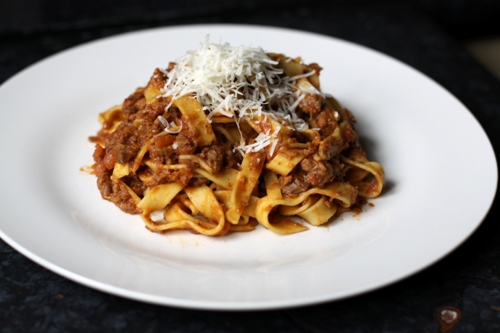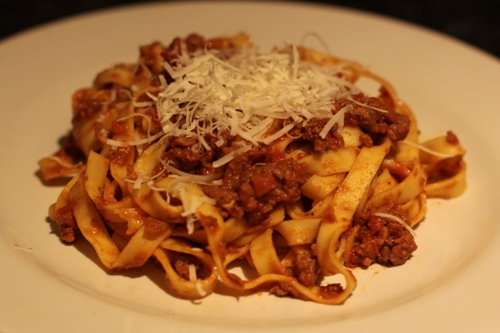A traditional ragù from Bologna
 Friday, April 26, 2013 at 9:43PM
Friday, April 26, 2013 at 9:43PM 
“I hate the way they call it ‘Bolognese’ here. It’s not Bolognese, it’s ragù. That is what they call it in Bologna" says my friend Geraldine as we peruse the lunch menu in Arbutus.
She’s French, but her father is Italian and so, more importantly, is her grandmother.
I once tried to argue with her about whether or not water must be at a rolling boil before putting pasta in it. I can’t remember what the correct answer was. I presume it was that it should be and that Geraldine was right. In her words:
“Well, I know you know a lot about food, Vicky, but I think I am going to listen to my Italian grandmother over you.”
It was a valid point, which I only admitted to her now, at least 10 years later.
Geraldine and I like to disagree. It is what our friendship was founded on. Each as stubborn as the other, and always looking for a good argument. So I had replied:
“Well, your grandmother probably makes her pasta from scratch. We’re just using dried pasta.”
Or I wished I did. I can’t remember.
Anyway, the point is not to enter into an argument about Italian food with an Italian. Especially, this Italian. She was, after all, treating me to the ragù in question. Nonetheless, in defence of my choice of restaurant, I did point out that they had put the word ‘Bolognese’ in inverted commas. I suspect this had more to do with the fact that it was made with hare, than because they were trying to point out a misconception on behalf of the English regarding the specifics of regional Italian cuisine. This I did not point out.
Instead I asked her how her grandmother makes it. Her grandmother is from Rubiera, not Bologna, which is in another part of Emilia Romagna. This may account for the differences between her ragù and the traditional recipe for Ragù alla Bolognese, as set out by the Accademia Italiana della Cucina. Of course there can never be a definitive recipe, but the Accademia have attempted to provide an 'official' one in line with their mandate to protect the traditions of Italian cuisine. Nonetheless, I am sure they would acknowledge the extent to which the recipe has changed over the years and allow for variation according to the preferences of the cook, or more importantly, their grandmother.
One point on which there does appear to be a general consensus is that traditionally Ragù alla Bolognese is served with tagliatelle, not spaghetti. Also, the Accademia’s recipe does not have any garlic in it – this I found much more surprising. There is less agreement on this; a number of the other recipes I consulted contained it. Still, I chose to go without and was amazed to find I didn’t miss it. I was equally surprised by the lack of herbs, which I did not miss either.
The meats which are used also vary. The main meat used to be veal, but most people use beef now. The Accademia’s recipe calls for beef mince from cuts of beef which are good for stewing. Geraldine’s grandmother uses a mix of beef, veal and pork sausage mince. Geraldine tells me that the sausage mince is her secret ingredient. It was this that inspired me to write this post, and it is fabulous, but I have since also tried this recipe with pancetta, as per most other recipes, and both lend the ragù a wonderfully rich depth of flavour.
Angela Hartnett, whose grandmother is also from Emilia Romagna, writes:
"I used to wonder why Nonna would spend ages cutting up beef for Bolognese sauce, rather than using minced beef ... The answer is because it tastes so much better."
I had always wanted to try this method and the conversation with Geraldine inspired me to do it at last. The difference is astounding. The consistency is like that of pulled pork, rather than grainy. If you can’t be bothered dicing the beef yourself, then get the butcher to mince it for you on a thick setting. This recipe simply isn’t the same with the mince you get in the supermarkets.
Another surprise might be the addition of milk. Marcella Hazan explains that this is to protect the beef from the acidic bite of the tomatoes, although I think it is probably more effective as a tenderiser. Also, she uses white wine rather than red, but I think this makes the dish too acidic. The Accademia’s recipe gives the choice of either white or red, so I have stuck with the latter.
So this recipe is an amalgamation of four recipes, though I have looked at others. First and foremost, I have followed the Accademia, then Angela Hartnett, Marcella Hazan and Geraldine’s grandmother have influenced me in equal measure.
Serves four as a main course.
Buon Appetito!

Ingredients
500g beef stewing steak, e.g. flank, skirt, shoulder
200g Italian pork sausages or 100g pancetta
1 tbsp olive oil
1 tbsp butter
1 large carrot, finely diced
2 sticks celery, finely diced
1 onion, finely diced
½ cup whole milk
½ cup red wine
800g tin plum tomato or 800g fresh, overripe tomatoes, skinned and diced
1 tbsp tomato puree
750ml approx chicken or vegetable stock
Salt and freshly ground black pepper, to taste
To serve
Fresh tagliatelle
Fresh parmesan cheese, grated
Method
Dice the beef as finely as possible using a meat cleaver or very sharp knife. Remove any large pieces of fat, but leave the rest in. Remove the skins from the sausages, if using these. Put to one side.
Heat the olive oil and melt the butter in a large heavy based saucepan over a low heat. If using pancetta, turn the heat up and fry for a minute before reducing the heat again to low. Add the carrot, celery and onion to the saucepan and sweat until soft, stirring occasionally.
Turn the heat up slightly and add the beef and the sausage mince, if using. Stir until beef is browned. Add the milk and simmer until the milk has evaporated, stirring frequently. Turn the heat up to medium and add the red wine. Simmer and reduce for 1 minute.
Add the tomatoes and tomato puree, stir and simmer for 5 minutes. Add 250ml of stock, turn down to the lowest heat and simmer for at least 2 hours, but longer is better (I did my last one for 6 hours), stirring and adding more stock as necessary. The longer you cook it, the more stock you will need. Season with salt and pepper, to taste.
After a few hours the beef should break down, but if it doesn’t the process can be aided by mashing with a potato masher. This is a good idea if you are pushed for time, but you need to have cooked it for at least 2 hours first. Adjust seasoning as necessary.
To serve
Cook the tagliatelle in a large saucepan of salted boiling water with a drizzle of olive oil. Drain and return to the saucepan. Toss with the ragù (you may not need all of it) before plating up.
Serve with grated parmesan cheese.
 Vix |
Vix |  3 Comments |
3 Comments | 
Reader Comments (3)
Very curious that there are no herbs in this. I do a simple ragu of this type from time to time but it would never occur to me not to use one of the fragrant food flavoring herbs. Infact I like to use just one herb at a time which never fails to change the taste a little for a change.
Rosemary, or thyme, oregano or Bay which is actually one of my favorites, and I probably always put some Garlic in, just because.
Hi Liza, if I wasn't trying to recreate the traditional recipe then I, too, would certainly add herbs and garlic. What amazed me, though, was that I didn't miss them at the end. Certainly, they would have added something, but the ragu was fabulous without. I will try next time and report back.
I am just back from Bologna. We dined at Trattoria di Pietro - I thought I ought to try "Bolognaise", being in Bologna, so I chose Tagliatelle di RAGÙ. I was disappointed. I am going to have a go at cooking your version to see if I like it better. The restaurant version was heavy on meat rather than sauce, and I couldn't taste tomato. On the other hand the starter was something else."Candied onion with hot and cold parmesan cheese" - it was caramelised onion with cheese icecream - as they in Italy ..."Ottimo!!!"